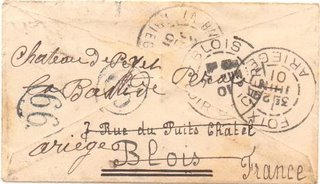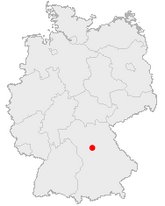

Here’s a tiny cover measuring only 3.5 x 2 inches sent unsealed at the five-centime printed matter rate. Initially, it was solely franked with a five-centime Adolphe definitive and posted from Redange-sur-Attert in Luxembourg’s Ardennes on June 22, 1901 to the French Consul, Monsieur le Costé, in Nuremberg, Bavaria. The little envelope probably contained a business or calling card. Its diminutive size, however, belies its substantial postal history content.


At the time (and until mid-1920), Bavaria retained its postal autonomy, even though it had joined the German Confederation in 1870. So when the cover arrived in Nuremburg after Consul le Costé had already moved on, it was forwarded by the Bavarian postal authorities on June 26, 1901, to 7 rue du Puits Chatel in the town of Blois on the lower Loire river in the French Département of Loir-et-Cher in north-central France. (A conscientious Bavarian postal clerk has even noted neatly in German Bitte Rückseite zu beobachten!, admonishing other postal clerks to look at the back side of the cover where the details of the forwarding address had been written.)

Forwarding from Bavaria to France apparently was not free, perhaps because Bavaria had never joined the Universal Postal Union despite retaining its postal autonomy until mid-1920, and long after having joined the German Confederation in 1870. Accordingly, a ten-pfennig and five-pfennig definitive were applied (presumably by the Nuremberg post office) so that the cover could enter the French postal system tax free, after which it went on its way again—with the Bavarian stamps postmarked Nuremberg, June 26, 1901.
The cover arrived in Blois on June 28, 1901, a historic town famous as a favorite residence of French kings and the venue from which Joan of Arc set out to raise siege of Orléans. But the peripatetic French consul had already continued on his journey, no doubt having enjoyed a few glasses of fine Loire Valley wine during his sojourn in historic Blois.
Now the little cover followed the French Consul to the Département of Ariège in the far South of France where the Pyrénées mountains form the border with Andorra and Spain. The transit postmark shows that the cover arrived at Foix, the capital of the Département, on June 29, 1901, en route to the forwarding address—the Chateau de Pevet in tiny La Bastide-de-Sérou—where it arrived later on the same day, finally to be (presumably) united with the addressee, Consul le Costé, about whom I unfortunately have been unable to find any biographic information.

The cover illustrates the richness of postal history, especially at the turn of the 19th century when postal clerks faithfully forwarded mail and mail carriers diligently sought out the recipients. This cover even bears the numerical majuscules of the French delivery clerks who first tried to deliver it in Blois and later delivered it in La Bastide-de-Sérou. Off cover, the three definitives would be valueless; on cover, however, they help us understand and enjoy the sort of journey that delights postal historians!
No comments:
Post a Comment